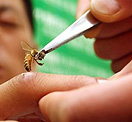Electronic Highways
Creatures comfort
There has never been a more compelling reason to ensure the survival of other creatures who share our planet. An ever-increasing number of species are helping us diagnose and treat disease.
Begin by checking out the Biotherapeutics, Education & Research Foundation, whose mission is to advance health care through education and research in biotherapy, or as they define it, the use of live animals to aid in the diagnosis or treatment of illness. The more familiar service animals, such as guide dogs or therapy animals, are included, but more intriguing are the pages on maggot therapy, leech therapy, bee venom therapy, helmintherapy, icthiotherapy, phage and microbial therapy, canine olfactory detection, pet therapy, therapeutic horse riding and hippotherapy—a form of physical, occupational and speech therapy in which a therapist uses the characteristic movements of a horse to provide carefully graded motor and sensory input.
Maggots are just one example of the revival of a centuries-old therapy that was discarded with the advent of modern antibiotics and other potent drugs. Medical maggots were approved by the Food and Drug Administration in 2004, more than 80 years after William S. Baer began his groundbreaking work at Johns Hopkins treating bone and soft tissue infections with live maggots (notably there is now a school named after him). Monarch Labs was approved as a supplier of Medical Maggots in the U.S. by the FDA in 2007.Check out a beautiful image of the little critters—Phaenicia sericata—at the National Library of Medicine’s Visible Proofs: Forensic Views of the Body online exhibit. Maggot therapy often is used on diabetic patients and other who have wounds that refuse to heal normally; the sanitized maggots are applied in a little pouch marketed as “creature comforts.” National Geographic’s Ultimate Explorer aired a segment titled “Creepy Healers” in 2003 that covered the topic nicely.
MEDLINE turns up more than 200 articles ranging from a conclusion that maggot infestation had a protective effect on a head trauma wound to a review of the value of various insect therapies, including maggots, bee and ant venom, and cantharidin, a derivative of the bodies of blister beetles (Cherniak EP. Bugs as drugs, Part 1: insects: the "new" alternative medicine for the 21st century? Alternative Medicine Review 15(2):124-35, 2010 Jul.).
Another ancient therapy that has experienced a resurgence is the use of leeches to keep blood circulating to reattached tissue. The American Journal of Nursing published a nice review on Leech Therapy in 2009, and a search in NLM’s Toxnet turns up 22 articles on leech therapy.Don’t miss viewing the antique and impressive Leech Jars and Leech Cage held in the Health Sciences Library’s History of Health Sciences collection on UBDigit.
If there was any doubt about the evidence for these biotherapies, a quick search on Evidence-Based Medicine Reviews turns up 14 and 35 articles on maggot and leech therapy, respectively. Not to mention that at least one insurance company, Aetna, issued a Clinical Policy Bulletin defining its coverage for Bio-Surgery: Medicinal Leech Therapy and Medical Maggots.
Bee-venom therapy, on the other hand, while also centuries old and advocated by many alternative practitioners, has gotten mixed results in scientific research. Still, it’s worthwhile to check out the American Apitherapy Society pages for a wide range of information about bee products and their uses. Raw honey, for example, has been advocated for centuries, both ingested and as a topical treatment for wounds.
Helmintherapy also is not yet ready for prime time. Few studies have shown measurable benefits from deliberate introduction of helminthes, such as hookworm and whipworm, which are considered health problems. Yet, sufferers of irritable bowel syndrome and Crohn’s disease have turned to such alternative treatments after other treatments have failed. Some studies show that deliberate infestations modulate the immune system as part of the organism’s wily way of protecting itself, and sellers have been quick to put up sites, such as Worm Therapy: Helminth Induced Immune Modulation. Don’t get out your credit card just yet!
Other critters are lending their secretions for analysis in developing new drugs. Vampire bat saliva, for example, contains a chemical more powerful than Coumadin (a drug used to thin blood) and without some of the side effects. The effect makes sense when you realize that vampire bats need to keep the blood of their hosts, usually cattle, flowing so they can eat! Desmoteplase, or DSPA, is now in clinical trials that hopefully will result in better therapies for stroke patients. For a good look at these marvelous creatures, visit the Buffalo Zoo’s Rainforest Falls Exhibit. Snake venom also is being widely studied for its therapeutic effects, including possible drugs against cancer. And finally, ziconotide (Prialt) is a pain medication derived from cone snail venom.
So the next time you’re tempted to capture that bat, squash that bug or kill that bee, reconsider: It may one day save your life.
—Pamela Rose, Web Services and Library Promotions Coordinator


Reader Comments